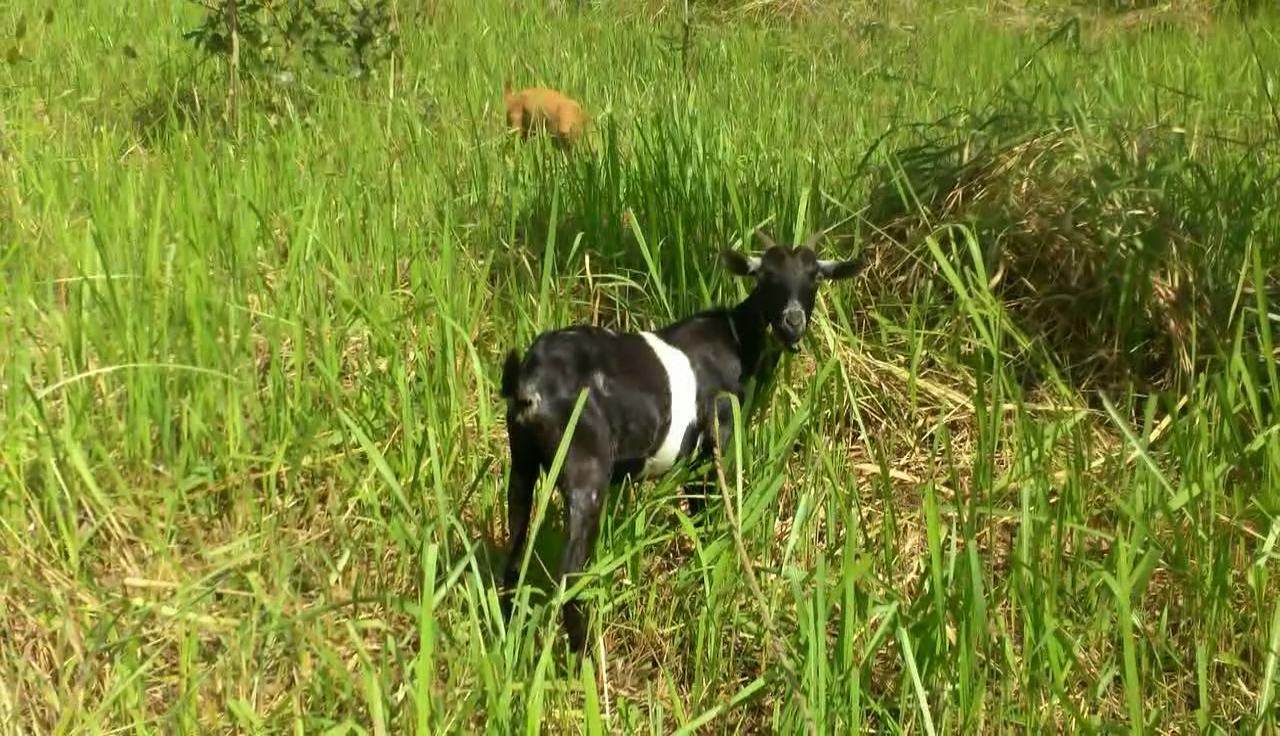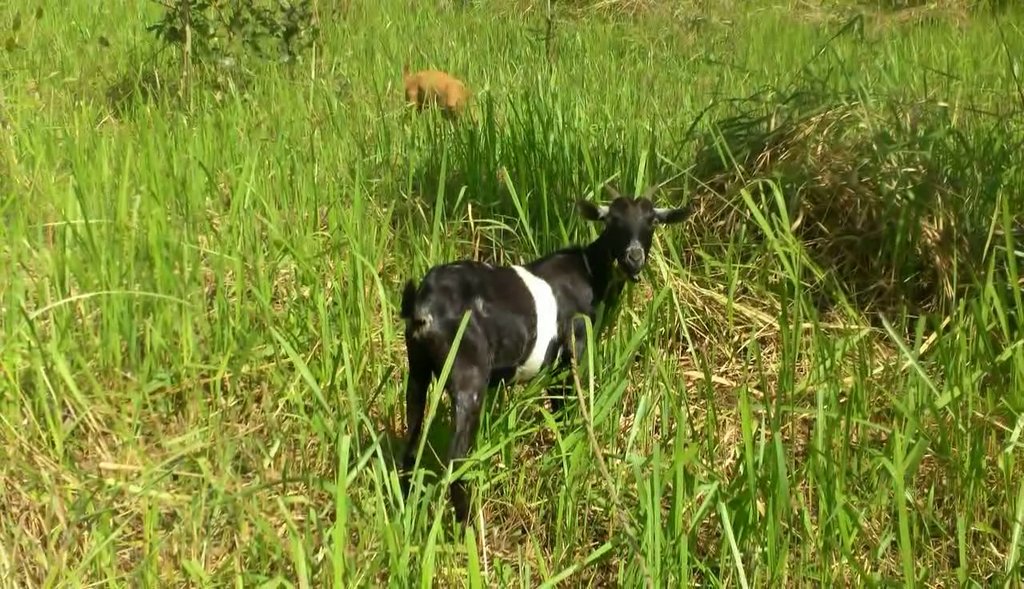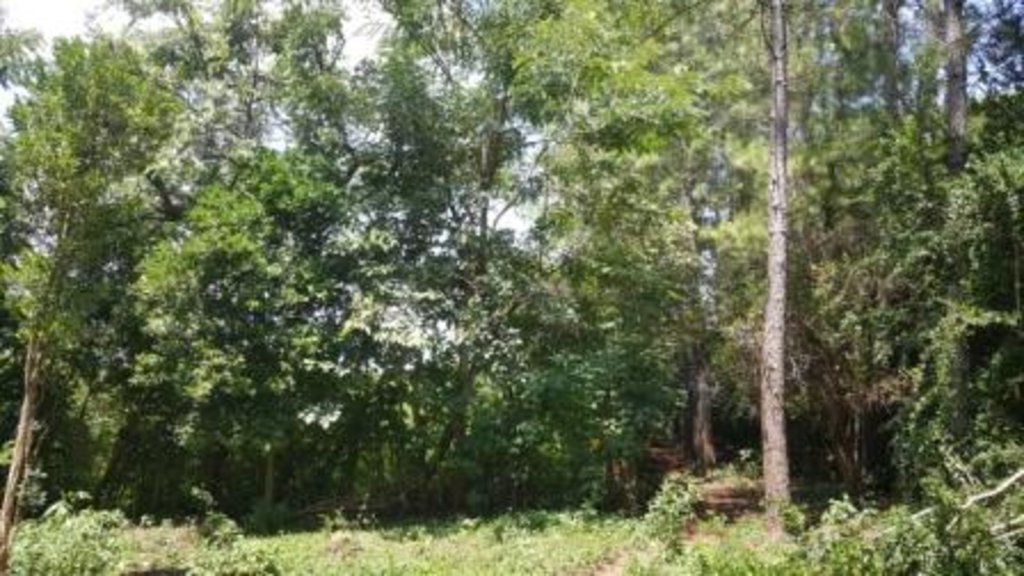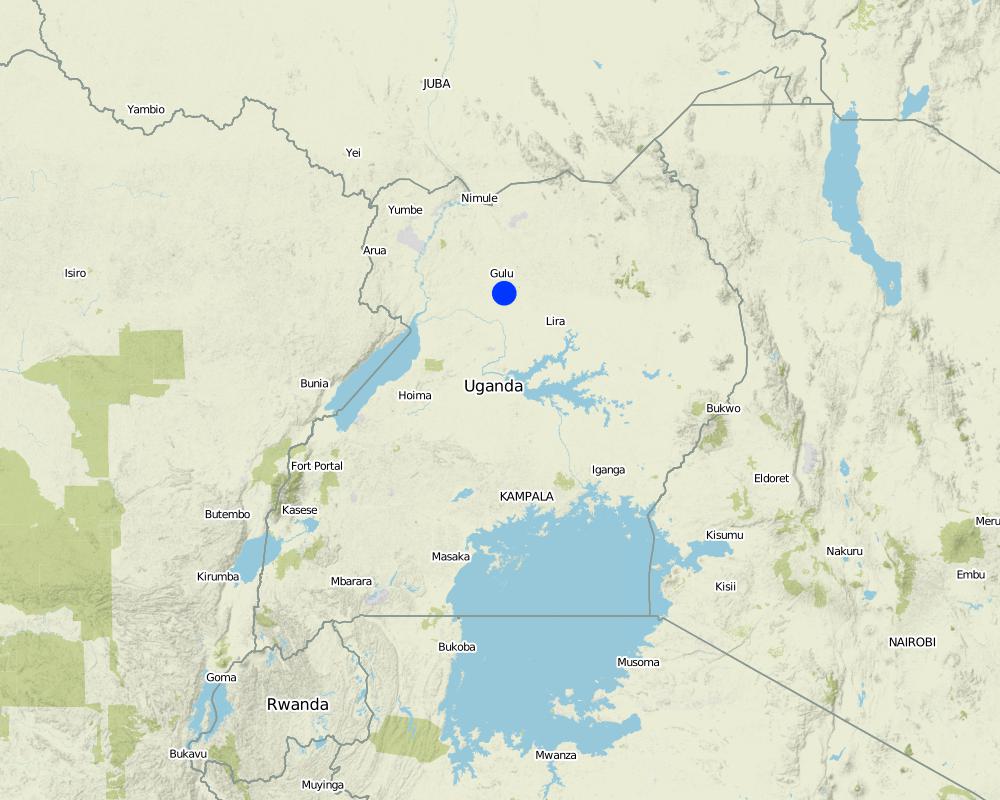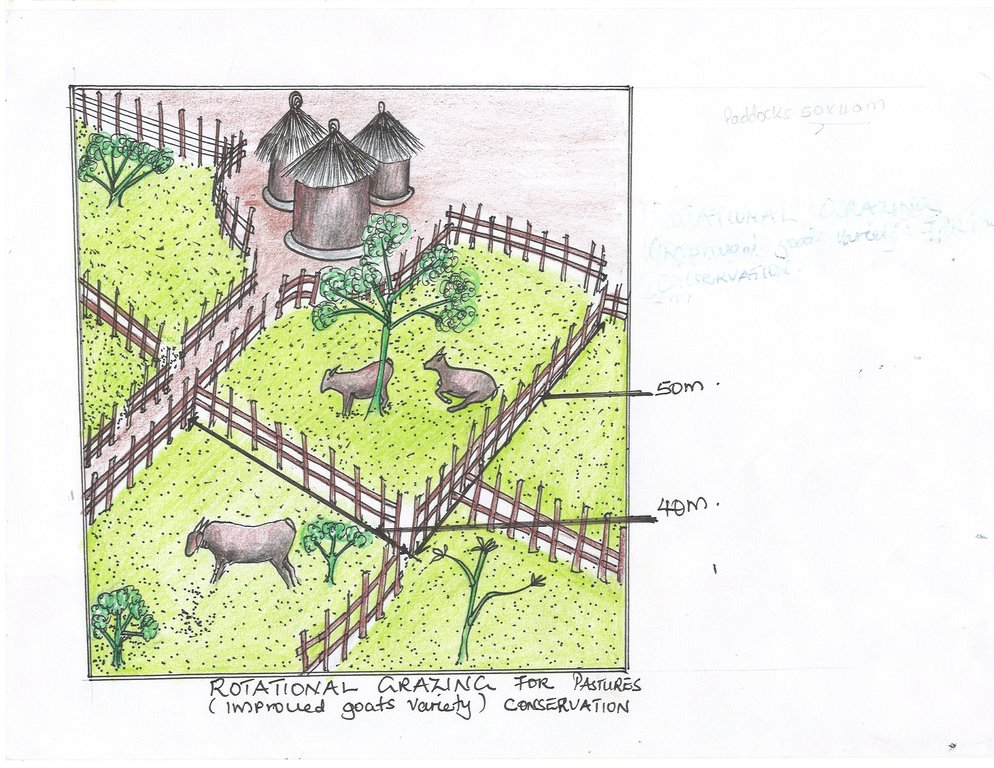Rotational grazing of goats for pasture conservation and improvement. [乌干达]
- 创建:
- 更新:
- 编制者: betty adoch
- 编辑者: JOY TUKAHIRWA
- 审查者: Drake Mubiru, Nicole Harari, Renate Fleiner, Stephanie Jaquet, Rima Mekdaschi Studer, Alexandra Gavilano
Gwoko Dyel
technologies_2147 - 乌干达
查看章节
全部展开 全部收起1. 一般信息
1.2 参与该技术评估和文件编制的资源人员和机构的联系方式
关键资源人
土地使用者:
Mwaka Abel
Omoro district, Bobi subcounty, Paidwe parish, Pato village.
乌干达
有助于对技术进行记录/评估的项目名称(如相关)
Scaling-up SLM practices by smallholder farmers (IFAD)有助于对技术进行记录/评估的机构名称(如相关)
CDE Centre for Development and Environment (CDE Centre for Development and Environment) - 瑞士1.3 关于使用通过WOCAT记录的数据的条件
编制者和关键资源人员接受有关使用通过WOCAT记录数据的条件。:
是
1.4 所述技术的可持续性声明
这里所描述的技术在土地退化方面是否存在问题,导致无法被认为是一种可持续的土地管理技术?:
否
注释:
Improves biodiversity in the grazing fields and improvement of soil fertility through rotational grazing where the goats wastes enhances soil fertility which enables the regeneration of natural pastures in the different paddocks.
2. SLM技术的说明
2.1 技术简介
技术定义:
Rotational grazing by improved goats variety enhances/ increases soil fertility, biodiversity and production of pastures and generates farmyard manure applied on cropland.
2.2 技术的详细说明
说明:
Rotational grazing is the shifting of livestock to different units of a pasture or range in regular sequence to permit the recovery and regrowth of the pasture plants after grazing, which increased forage production. Forage that are over-grazed or are less healthy from being grazed every few days have smaller root mass, which leads to less soil organic matter. Northern Uganda has tropical savannah climate characterized by moderate rainfall of 750-1000mm per annum. This region also experiences prolonged dry spells from June to July and also November to March characterised by wild fire outbreaks which retards pasture growth. Because of this, land user has to conserve pastures through rotational grazing in a paddock system. The land is gently sloping with moderate soil humus that has also supported the growth of pastures. The land user is a subsistence farmer who graze goat in a paddock system for pasture conservations, manure generation for cropland, and goats for home consumptions and sale. About 90% of his income is from on farm activities.
A well-managed controlled grazing program can increase quality forage production by 30-70% each year. Much of this increase in forage production is accomplished by minimizing overgrazing. In this technology, six paddocks were created measuring 40x50meters on a five acres’ piece of land. Goats are shifted from one paddock to another in an interval of one month and later shifted to another section. The water tank is also moved as the goats are shifted to another paddocks. The shifting is to reduce on overgrazing. The land user has 40 goats. Two paddocks are grazed at the same time with each having a carrying capacity of 20goats to minimize on overcrowding and congestion at the water point. controlled grazing is practiced in order to protect the area from the damages of grazing that is digging up roots and everything in the field since this will de-grass an area and make it susceptible for erosion. By limiting graze time, fields can produce all year round instead of being a one-time harvest. Goats are not allowed to graze a paddock until it is at least 10 to 12 inches in height. If grazed any shorter, this compromises root recovery, energy storage in the roots, and grass' ability to depend on photosynthesis alone. This is why the land user preferred rotational grazing to prevent overgrazing, and allow the forage plenty of time to recover.
The inputs needed for the establishment of this technology are pangas, hand hoes, slashers, poles, and labour force to carry out the work of paddock constructions. To main the technology, the over grown grass is slashed to a height of 10 to 12 inches in height which is consumable by goats, water point is cleaned every two weeks to avoid contamination, paddocks repaired and goats constantly checked for treatment
The technology provides beneficial impacts like improvement of organic matter content and pasture soil fertility as a result of spreading manure around the whole pasture while grazing and browsing. Grazing goats typically return to the water tanks or a single favourite shade tree. The manure deposited around water tanks/tree shade is collected and used as farmyard manure for the seasonal crop production like cereals, vegetables, and legumes.
The technology is disliked because it is tedious to look after so many goats, wild animal attacks and drought affects water supply and pasture growth for the goats.
2.3 技术照片
2.4 技术视频
注释、简短说明:
Goats grazing in the natural pastures
日期:
28/04/2017
位置:
Omoro District, Bobi Sub County, Paidwe Parish, Pato Village.
摄影师的名字:
Betty Adoch
2.5 已应用该技术的、本评估所涵盖的国家/地区/地点
国家:
乌干达
区域/州/省:
Northern Uganda.
有关地点的进一步说明:
Omoro District.
具体说明该技术的分布:
- 均匀地分布在一个区域
如果不知道精确的区域,请注明大致覆盖的区域:
- 0.1-1 平方千米
注释:
The GPS point shows the land user grazing ground. Rotational grazing.
Map
×2.6 实施日期
注明实施年份:
2003
如果不知道确切的年份,请说明大概的日期:
- 10-50年前
2.7 技术介绍
详细说明该技术是如何引入的:
- 通过土地使用者的创新
注释(项目类型等):
Diversify source of income, improve on nutrition and improve soil fertility.
3. SLM技术的分类
3.1 该技术的主要目的
- 减少、预防、恢复土地退化
- 保持/提高生物多样性
- 适应气候变化/极端天气及其影响
- 减缓气候变化及其影响
- 创造有益的经济影响
- 创造有益的社会影响
3.2 应用该技术的当前土地利用类型

农田
- 一年一作
年作 - 具体指明作物:
- 谷物类 - 玉米
- 谷类 - 高粱
- simsim
每年的生长季节数:
- 2
具体说明:
Rainfall is moderate which sustains pasture growth.

牧场
集约放牧/饲料生产:
- 改良牧场
- Rotational grazing
动物类型:
- 牛 - 非奶牛牛肉
- 山羊
- 家禽
- The goats graze the paddocks twice a year.
品种:
牛 - 非奶牛牛肉
计数:
8
品种:
山羊
计数:
40
品种:
家禽
计数:
50
注释:
conservation of pastures
3.4 供水
该技术所应用土地的供水:
- 雨养
注释:
Rainfall is moderate which sustains pasture growth.
3.5 该技术所属的SLM组
- 轮作制度(轮作、休耕、轮垦)
- 农畜综合管理
3.6 包含该技术的可持续土地管理措施

农艺措施
- A1:植被和土壤覆盖层
- A2:有机质/土壤肥力

管理措施
- M1:改变土地使用类型
- M2:改变管理/强度级别
- M3:根据自然和人文环境进行布局

其它措施
注释:
The mixed cropland is easily managed with livestock which provides manures to the cropland leading to high crop yields and pasture conservation.
3.7 该技术强调的主要土地退化类型

土壤水蚀
- Wt:表土流失/地表侵蚀

物理性土壤退化
- Pc:压实

生物性退化
- Bc:植被覆盖的减少
- Bs:质量和物种组成/多样性的下降
注释:
high risks of fire outbreaks and prolonged dry spells.
3.8 防止、减少或恢复土地退化
具体数量名该技术与土地退化有关的目标:
- 防止土地退化
- 减少土地退化
注释:
To promote diversification and prevent land degradation.
4. 技术规范、实施活动、投入和成本
4.1 该技术的技术图纸
技术规范(与技术图纸相关):
Five acres of land under paddock system of rotational grazing. The paddocks measures 40x50meter. Poles of about 1meter high are used to fenced the paddocks.
作者:
Betty Adoch
日期:
28/04/2017
4.2 有关投入和成本计算的一般信息
具体说明成本和投入是如何计算的:
- 每个技术区域
注明尺寸和面积单位:
5acres
其它/国家货币(具体说明):
UGX
如相关,注明美元与当地货币的汇率(例如1美元=79.9巴西雷亚尔):1美元=:
3718.0
注明雇用劳工的每日平均工资成本:
1000shs
4.3 技术建立活动
| 活动 | 时间(季度) | |
|---|---|---|
| 1. | Clearning the bush through digging and slashing | Dry season. |
| 2. | Marking the paddocks and planting poles | Dry season |
| 3. | Fencing the area | Dry season |
| 4. | Installing the water tank | Dry season |
| 5. | Introducing the goats into the paddock | Rainy season |
注释:
Easy to eastablish rotational grazing.
4.4 技术建立所需要的费用和投入
注释:
The cost is manageable by the land user.
4.5 维护/经常性活动
| 活动 | 时间/频率 | |
|---|---|---|
| 1. | Slashing the over grown grass | wet season |
| 2. | cleaning the water tank | wet and dry season |
| 3. | Refilling the water tank | wet and dry season |
| 4. | Repairing the paddock | Dry season |
| 5. | Creating firelines | dry season |
注释:
The land user protects his farm from the danger of fire outbreaks and pests.
4.6 维护/经常性活动所需要的费用和投入(每年)
注释:
Record keeping is not done by the farmer.
4.7 影响成本的最重要因素
描述影响成本的最决定性因素:
The labour costs for fencing the paddocks, and the high costs of fencing materials.
5. 自然和人文环境
5.1 气候
年降雨量
- < 250毫米
- 251-500毫米
- 501-750毫米
- 751-1,000毫米
- 1,001-1,500毫米
- 1,501-2,000毫米
- 2,001-3,000毫米
- 3,001-4,000毫米
- > 4,000毫米
有关降雨的规范/注释:
The rainfall is moderate and unreliable.
注明所考虑的参考气象站名称:
Gulu meterological station.
农业气候带
- 半湿润
Climate is suitable for pasture growth.
5.2 地形
平均坡度:
- 水平(0-2%)
- 缓降(3-5%)
- 平缓(6-10%)
- 滚坡(11-15%)
- 崎岖(16-30%)
- 陡峭(31-60%)
- 非常陡峭(>60%)
地形:
- 高原/平原
- 山脊
- 山坡
- 山地斜坡
- 麓坡
- 谷底
垂直分布带:
- 0-100 m a.s.l.
- 101-500 m a.s.l.
- 501-1,000 m a.s.l.
- 1,001-1,500 m a.s.l.
- 1,501-2,000 m a.s.l.
- 2,001-2,500 m a.s.l.
- 2,501-3,000 m a.s.l.
- 3,001-4,000 m a.s.l.
- > 4,000 m a.s.l.
说明该技术是否专门应用于:
- 凸形情况
关于地形的注释和进一步规范:
The landscape is generally gentle easy to practice rotational grazing.
5.3 土壤
平均土层深度:
- 非常浅(0-20厘米)
- 浅(21-50厘米)
- 中等深度(51-80厘米)
- 深(81-120厘米)
- 非常深(> 120厘米)
土壤质地(表土):
- 中粒(壤土、粉土)
土壤质地(地表以下> 20厘米):
- 粗粒/轻(砂质)
表土有机质:
- 中(1-3%)
5.4 水资源可用性和质量
地下水位表:
5-50米
地表水的可用性:
好
水质(未处理):
良好饮用水
水的盐度有问题吗?:
否
该区域正在发生洪水吗?:
否
关于水质和水量的注释和进一步规范:
suitable for human consuptions and animals .
5.5 生物多样性
物种多样性:
- 高
关于生物多样性的注释和进一步规范:
Different species of plants and animals coexist in the environment.
5.6 应用该技术的土地使用者的特征
定栖或游牧:
- 定栖的
生产系统的市场定位:
- 混合(生计/商业)
非农收入:
- 低于全部收入的10%
相对财富水平:
- 平均水平
个人或集体:
- 个人/家庭
机械化水平:
- 畜力牵引
性别:
- 男人
土地使用者的年龄:
- 中年人
说明土地使用者的其他有关特征:
He totally depends on farming for livelihood.
5.7 应用该技术的土地使用者使用的平均土地面积
- < 0.5 公顷
- 0.5-1 公顷
- 1-2 公顷
- 2-5公顷
- 5-15公顷
- 15-50公顷
- 50-100公顷
- 100-500公顷
- 500-1,000公顷
- 1,000-10,000公顷
- > 10,000公顷
这被认为是小规模、中规模还是大规模的(参照当地实际情况)?:
- 小规模的
5.8 土地所有权、土地使用权和水使用权
土地所有权:
- 个人,有命名
土地使用权:
- 个人
用水权:
- 社区(有组织)
注释:
The technologies secure the land from land grabbers within the community. The land user has full right over his land.
5.9 进入服务和基础设施的通道
健康:
- 贫瘠
- 适度的
- 好
教育:
- 贫瘠
- 适度的
- 好
技术援助:
- 贫瘠
- 适度的
- 好
就业(例如非农):
- 贫瘠
- 适度的
- 好
市场:
- 贫瘠
- 适度的
- 好
能源:
- 贫瘠
- 适度的
- 好
道路和交通:
- 贫瘠
- 适度的
- 好
饮用水和卫生设施:
- 贫瘠
- 适度的
- 好
金融服务:
- 贫瘠
- 适度的
- 好
6. 影响和结论性说明
6.1 该技术的现场影响
社会经济效应
生产
饲料生产
SLM之前的数量:
negative
SLM之后的数量:
positive
注释/具体说明:
Due to conserved pastures.
水资源可用性和质量
饮用水的可用性
SLM之前的数量:
negative
SLM之后的数量:
positive
注释/具体说明:
Source of water is secured by the land user.
家畜用水的可用性
SLM之前的数量:
slightly negative
SLM之后的数量:
very positive
注释/具体说明:
Water filled in a tank for goats consumption.
家畜用水的质量
SLM之前的数量:
negative
SLM之后的数量:
positive
注释/具体说明:
Goats fenced off which avoid water contamination.
收入和成本
农业收入
SLM之前的数量:
negative
SLM之后的数量:
positive
注释/具体说明:
Rotational grazing has saved the land user from purchasing animal feeds which would be very expensive.
社会文化影响
SLM/土地退化知识
SLM之前的数量:
negative
SLM之后的数量:
very positive
注释/具体说明:
Land user is aware of climate smart agriculture which has a lots of site benefits in terms of increased animal productions.
生态影响
水循环/径流
蒸发
SLM之前的数量:
very positive
SLM之后的数量:
very negative
注释/具体说明:
Grass cover the soil from effects of evaporation.
土壤
土壤水分
SLM之前的数量:
negative
SLM之后的数量:
positive
注释/具体说明:
Grass covers the soil from erosion.
土壤覆盖层
SLM之前的数量:
slightly negative
SLM之后的数量:
very positive
注释/具体说明:
Grass covers the soil from being exposed to agents of erosion.
土壤流失
SLM之前的数量:
very positive
SLM之后的数量:
very negative
注释/具体说明:
The grass covers the soil from erosion.
土壤压实
SLM之前的数量:
very positive
SLM之后的数量:
very negative
注释/具体说明:
Grazing goats loosen the soil particles which helps in fertile soil formation.
生物多样性:植被、动物
生物量/地上C
SLM之前的数量:
negative
SLM之后的数量:
very positive
注释/具体说明:
Dry grass decompose to form humus.
植物多样性
SLM之前的数量:
negative
SLM之后的数量:
positive
注释/具体说明:
Different vegetation covers exist in the grazing fields.
减少气候和灾害风险
火灾风险
SLM之前的数量:
very positive
SLM之后的数量:
very negative
注释/具体说明:
Fire lines are created during dry seasons to prevent wildfire spread to the grazing fields.
6.2 该技术的场外影响已经显现
缓冲/过滤能力
SLM之前的数量:
negative
SLM之后的数量:
positive
注释/具体说明:
Grass roots filters and purifies the surface water.
对邻近农田的破坏
SLM之前的数量:
positive
SLM之后的数量:
negative
注释/具体说明:
Goats are fenced off from crop land reducing unnecessary destruction.
温室气体的影响
SLM之前的数量:
high
SLM之后的数量:
low
注释/具体说明:
conserved vegetation acts as carbon sink
对场外影响(测量)的评估进行具体说明:
The technology is highly sustainable.
6.3 技术对渐变气候以及与气候相关的极端情况/灾害的暴露和敏感性(土地使用者认为的极端情况/灾害)
注释:
The technology is sustainable.
6.4 成本效益分析
技术收益与技术建立成本相比如何(从土地使用者的角度看)?
短期回报:
稍微积极
长期回报:
积极
技术收益与技术维护成本/经常性成本相比如何(从土地使用者的角度看)?
短期回报:
稍微积极
长期回报:
积极
注释:
The farmer has been able to generate income to improve his standard of living.
6.5 技术采用
- 1-10%
在所有采用这项技术的人当中,有多少人是自发的,即未获得任何物质奖励/付款?:
- 0-10%
注释:
The technology has inspired many community members to engage in sustainable land management practices.
6.6 适应
最近是否对该技术进行了修改以适应不断变化的条件?:
是
若是,说明它适应了哪些变化的条件:
- 气候变化/极端气候
具体说明技术的适应性(设计、材料/品种等):
indegineous pastures are conserved for the goats.
6.7 该技术的优点/长处/机会
| 土地使用者眼中的长处/优势/机会 |
|---|
| Conserve indegineous pastures. |
| The vegetation roots filters the surface water. |
| 编制者或其他关键资源人员认为的长处/优势/机会 |
|---|
| Availability of pastures for the goats through out the year. |
| The paddocks protects the land from land wrangles. |
6.8 技术的弱点/缺点/风险及其克服方法
| 土地使用者认为的弱点/缺点/风险 | 如何克服它们? |
|---|---|
| Limited capital to establish the paddocks. | Extenal support from doners. |
| Prolonged dry spells that retards pastures growth. | Practice climate smart agriculture like rotational grazing. |
| 编制者或其他关键资源人员认为的弱点/缺点/风险 | 如何克服它们? |
|---|---|
| Limited labour force to look after the goats. | Employing farm workers. |
| Pests and diseases that disturb the goats. | Technical services from the extension workers. |
7. 参考和链接
7.1 信息的方法/来源
- 实地考察、实地调查
one
(现场)数据是什么时候汇编的?:
28/04/2017
7.2 参考可用出版物
标题、作者、年份、ISBN:
Mixed crop-livestock farming - FAO
可以从哪里获得?成本如何?
www.fao.org/docrep/004/Y0501E/y0501e03.htm
7.3 链接到网络上的相关信息
标题/说明:
Mixed farming | ClimateTechWiki
URL:
www.climatetechwiki.org/content/mixed-farming
链接和模块
全部展开 全部收起链接
无链接
模块
无模块


